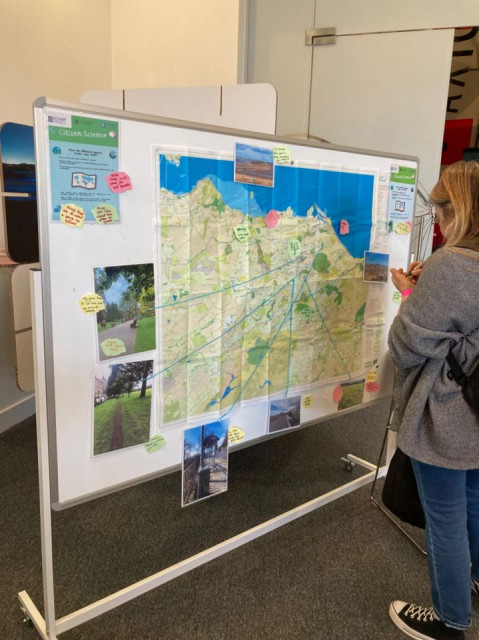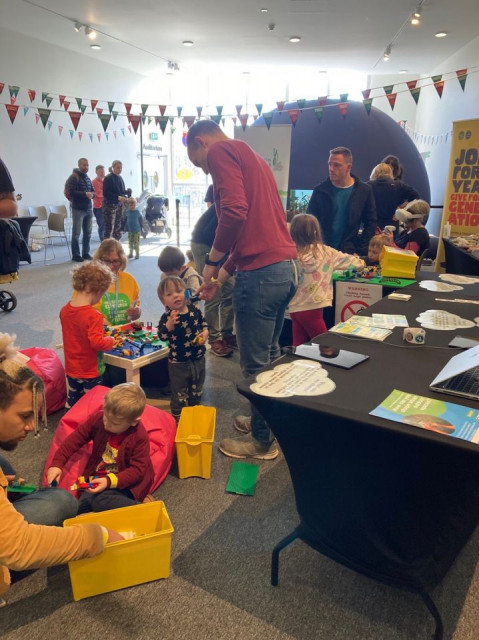By Diana Grunberg MBBChBAO, MPH
On the weekend of April 15, 2023, SCHPHRPers headed down to the Museum of Scotland for the Edinburgh Science Festival to engage with the key players (citizens!) of our citizen science project Groundswell and to promote its accompanying OurOutdoors app. Our target population had no age limits, as we enticed both parents and children alike with our comprehensive LEGO® "create-your-own outdoor space" section—including a competition for the most impressive design—and an interactive map of urban blue and green spaces throughout the region. We encouraged keen festival goers to physically jot down and post their thoughts and feelings about the varying spaces on the map, which understandably sparked fervent conversations about people's favourite outdoor areas and those that were less inspiring or were considered to require some much-needed TLC.
While it is obvious that the success of our project and app depends on citizen-user engagement, it is more important than ever to tangibly include the public in science research and development.
In our world of increasing awareness around equity and equality, it is about time that seemingly impenetrable institutions, like that of science with its strict methodologies and jargon, start thinking deeply about the ways in which these principles can be materially incorporated into our work– and this is precisely what we are setting out to do in the Groundswell project and the OurOutdoors app.
So where do we begin? Well, LEGO® is a good place to start! Using LEGO® as a means of science communication for all ages is a budding strategy that is increasingly becoming a studied academic discipline due to its promising application across many fields like pharmacology1, geology2, robotics3, environmental research and policy4, and of course public health. There are numerous benefits and exciting potentials in using LEGO® to engage the public, as outlined by Flack and colleagues at the University of Wisconsin-Madison: they are fun, colourful, emphasize visual and tactile interactions, facilitate group discussion, structures can be readily digitized, and are easy to acquire worldwide4. Indeed, our team was amazed to see just how many outdoor/environmental LEGO® kits and pieces exist, which offered children at the event both the freedom and necessary creative license to design the park or outdoor environment of their dreams. Truly, the world was at their fingertips!
Interestingly, Flack's group employed LEGO® pieces in their "What color is ___?" project to offer a unique survey experience for families to "colour" encode their answers to questions about themselves and their community4. As one can imagine, there is great potential for the Groundswell team to both adopt and adapt this type of surveying method in future events, especially as we are interested in understanding how different spaces invoke a sense of wellbeing or not—an abstract and emotional question that may be better captured by tapping into the senses through LEGO® creative expression. This approach may also appeal to different types of learners (i.e., visual, tactile), reflecting our goal of inclusivity in scientific communication.
Naturally when we think of LEGO®, we think of children; and as the saying goes, "children are the future," which is also what they say about science. Yet since the shift of science communication from a linear diffusion model (e.g., speeches, television broadcasts) to a dialogic model (focusing on talks or seminars from scientists to non-scientists), children have been precluded from these conversations, despite being one of the main target groups for science communication, according to Merzagora and Jenkins5. Importantly, the authors point out in their comment in the Journal of Science Communication that listening to children and empowering them is not just a choice, but a responsibility for all nations that have signed the UN convention on the rights of child. Indeed, Article 12 declares we "shall assure to the child who is capable of forming his or her own views the right to express those views freely in all matters affecting the child, the views of the child being given due weight in accordance with the age and maturity of the child". Practically speaking, how do we implement these lofty goals into not only science, but the world at large? For some inspiration, we can look to the following truly remarkable examples: the Reggio school in Madrid that was pupil and architect co-designed; student-led biodiversity efforts at the museum National d'Histoire Naturel de Paris; teenage journalists in Sardinia who conduct their own interviews/research and are the decision-makers in defining the relevance of their scientific content5. When considering the Groundswell project, it is exciting to think about the possibilities of including children in a meaningful way to co-create new, imaginative outdoor spaces that are purpose-built with children's wellbeing in mind. That said, I am getting a feeling that we may need a lot more LEGO®!
Whilst the priorities of the children at the event related to selecting the perfect LEGO® additions to their creations and bargaining for pieces with their peers, the adults had their minds elsewhere: they wanted to know how they could use the OurOutdoors app to change their communities and influence policy. While their questions challenged both the limits and application of the app for real world change, it was exciting to relay that the larger Groundswell project and OurOutdoors app were designed with these exact questions in mind, and with the capacity for high level change built-in from inception. As one can imagine, we had many enthusiastic festivalgoers download the app on the spot, often while keeping one eye on their children who were eagerly diving into buckets of LEGO®.
Overall, what did we learn from this event? Well, firstly, that people of ages love LEGO®, and secondly, that citizens want an active way to collect, collate, and report data to local government for community green/blue space improvement. Going forward, it is motivating to think about how we can implement more streamlined pathways for citizens to access the data collected in the OurOutdoors app to be used for positive change, and how we can expand our science communication methods to be more inclusive of children and minority groups…and, of course, how we can grow our LEGO® collection too!
References:
- 1.Kirby, BP, Pawlikowska, T. (2019). Pharmacology through Play: using Lego® to revise core concepts for undergraduates [version 1]. MedEdPublish, 8(201). https://doi.org/10.15694/mep.2019.000201.1
- 2.Heinze, T. (2020). Demonstrating granular flow characteristics easily using LEGO bricks. EGU General Assembly 2020, Online, 4–8 May 2020, EGU2020-4204. https://doi.org/10.5194/egusphere-egu2020-4204, 2020
- 3. (2021). Assessing the environmental quality of an adapted, play-based LEGO® robotics program to achieve optimal outcomes for children with disabilities. Disability and Rehabilitation, 43(25), 3613-3622, DOI: 10.1080/09638288.2020.1743776
- 4.Flack S, Ponto K, Tangen T, Schloss KB. (2019). LEGO as Language for Visual Communication. Presented at VisComm: Workshop on Visualization for Communication, IEEE VIS.
- 5.Merzagora, M, Jenkins, T. (2013). Listening and empowering: Children and science communication. Journal of Science Communication, 12. DOI: 10.22323/2.12030301
Comments
By accepting you will be accessing a service provided by a third-party external to https://www.ouroutdoors.net/
This website uses no external trackers, no analytics, just session cookies and values your online privacy.





